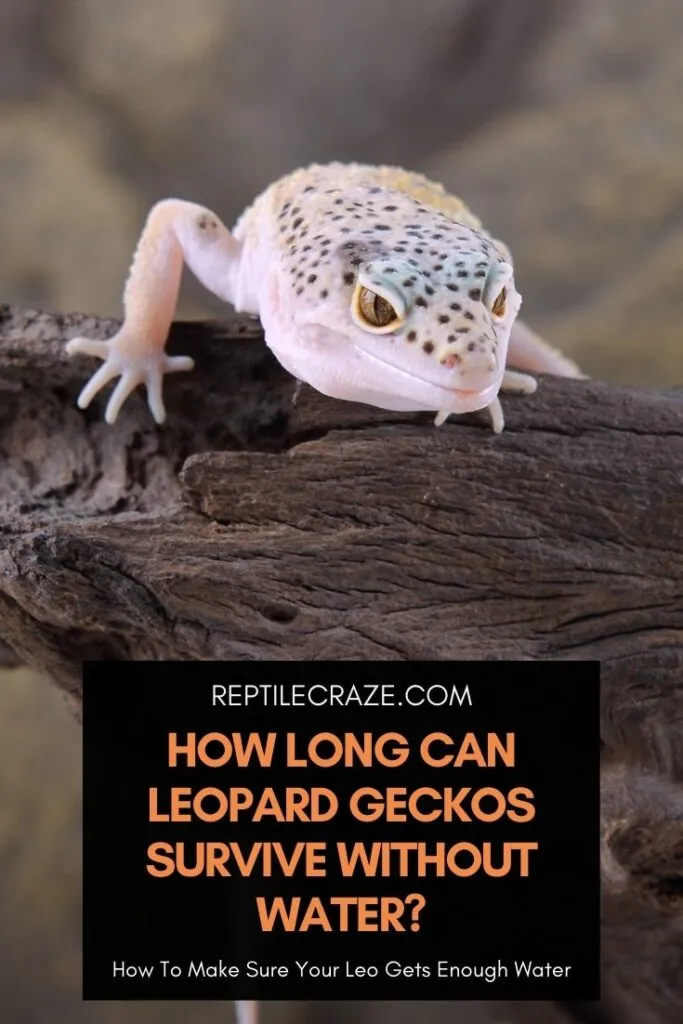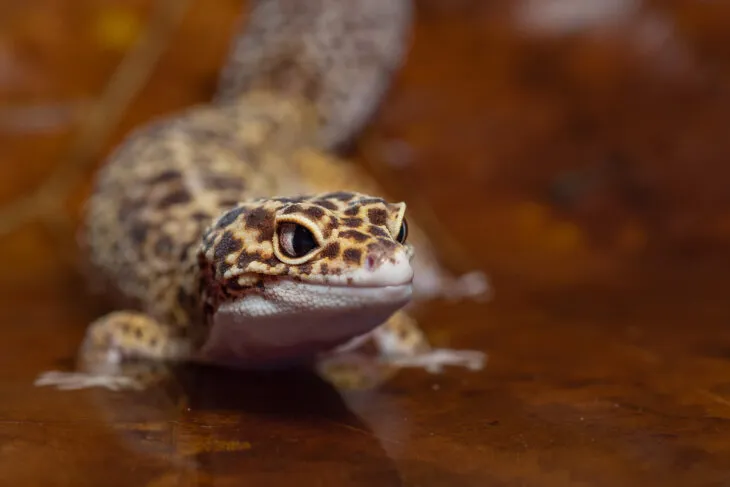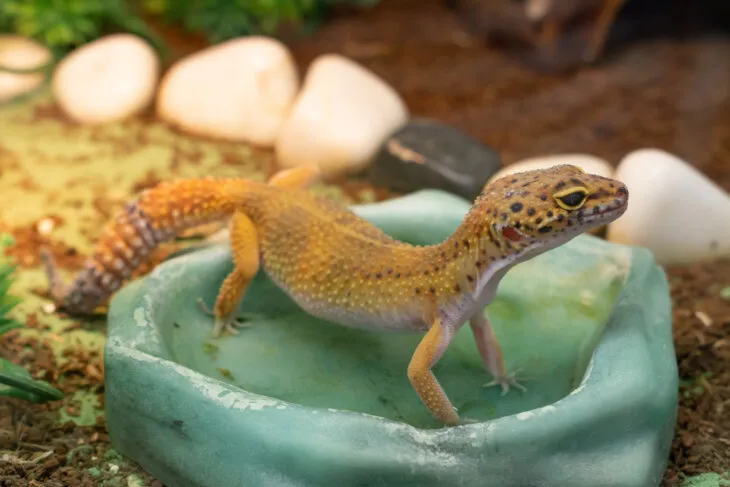
Caring for a leo can be a little intimidating for first-timers, especially aspects relating to diet and hydration. Whether you are a gecko owner with travel plans or if your reptile has developed an aversion to drinking, asking how long can leopard geckos survive without water isn’t uncommon.
While there’s no set timeline, a healthy leopard gecko can last up to 48 to 72 hours without water before dehydration sets in. However, it’s important to note that several factors can affect how long a gecko can go without water, for example, health, humidity, shedding, egg-laying, etc.
If you’re hoping to understand how gecko hydration works and how to keep your reptile safe from dehydration, you’re in the right place. This article will walk you through how long leopard geckos can stay without H2O, issues that can delay or hasten dehydration, and related symptoms.
Table of Contents
How Long Can Leopard Geckos Safely Go Without Water?
A leopard gecko can generally go without water safely for two to three days. Even though leos are native to arid terrains, they require water to survive like all living things.
These reptiles derive moisture from several sources: drinking water, soaking, live feeders, and even misting.
However, leo enthusiasts should remember that a number of factors can affect the above timeframe.
Factors That Affect How Long Leopard Geckos Can Go Without Water
So let’s have a look at those factors:
1. Health
Healthy reptiles have a higher chance of avoiding concerns like dehydration because their systems aren’t fighting off any illness.
For instance, parasites are a common health concern for geckos and can often present symptoms like diarrhea.
A leopard gecko suffering from diarrhea is at a greater risk for dehydration because its body is already losing water via loose stools.
Similarly, if your leo is Vitamin-A deficient, it’s bound to suffer from lethargy, which can be worsened through dehydration.
Tip: Read our water guide to learn what water your leopard gecko really needs!
2. Live Vs. Dried Feeders
Experts recommend feeding leopard geckos live feeder insects with high moisture content like crickets (more info here) and black soldier fly larvae (more info here) because they contribute significantly to keeping your reptile hydrated.
What’s more, leos are often fussy about drinking water, which means, if you’re feeding your pet dried feeders (be it freeze-dried or otherwise), then it’s possible its hydration needs aren’t being met.
Feeding leopard geckos dried feeder insects doesn’t just impact their nutritional intake, but it can also put them at an increased risk of dehydration.
If you still think about feeding dead or dried insects, we highly recommend reading these articles:
- Feeding a leo dried crickets
- Feeding a leo dried mealworms
- Why leopard geckos shouldn’t eat dead crickets
- How to get a leo to eat dead food
3. Humidity
Leopard geckos don’t do well in excessive humidity. However, low humidity levels can also negatively impact your reptile’s health. Optimals levels of humidity for geckos range between 30 to 40 percent.
If the moisture level in your leo’s enclosure is below the required range, it can cause problems with shedding and make your reptile more susceptible to harm without adequate sources of hydration.
This is why vets often recommend soaking leopard geckos in warm water when facing mild dysecdysis.
Likewise, geckos exposed to low moisture levels are more prone to facing concerns when they go without water for two to three days.

4. Egg-Laying
Once they reach sexual maturity, female leopard geckos will start ovulating. This means the gecko will produce eggs at regular intervals to lay or absorb back into its body, depending on mating.
Pregnant leos require special care regarding supplements (calcium powder), a nutrient-rich diet, and proper hydration.
Without these considerations, problems like egg-binding can occur. Conversely, leopard geckos will generally absorb unfertilized eggs to absorb their nutrients.
Nonetheless, ovulating geckos tend to experience a lack of appetite. Regardless of whether the eggs are fertile, it’s best not to expose them to any situation that could bring on dehydration.
In short, ovulating reptiles could likely be more sensitive to negative health concerns if they go without water for long.
5. Shedding
As already discussed, leopard geckos need water for more than just hydration because moisture also aids the process of shedding. That’s why gecko owners will often mist their reptiles’ tanks to help them get rid of dead skin with ease.
Shedding can also impact how long a leo can go without water. The lack of moisture or hydration during this time can exacerbate dysecdysis leading to the constriction of digits (toes).
This, in turn, can cause your reptile’s toes to fall off and bring about infections.
How Long Can Baby Leopard Geckos Go Without Water?
Baby leopard geckos need a high protein and high-fat diet to provide enough energy for their growing needs. Besides that, they also require a constant source of fresh water (i.e., a water dish) like their grown-up counterparts.
However, baby geckos require humidity levels between 50 to 70 percent to ensure they remain hydrated and can shed their skin without problems.
That means it’s highly possible that baby geckos can fall prey to dehydration much faster than adult geckos and shouldn’t be kept without water for long.
Signs Of Dehydration
Gecko owners worried about tackling dehydration in its early stages need to be aware of the potential symptoms. Here are some sure-shot signs of the onset of lack of moisture in leopard geckos:
- Tacky or dry mucous membranes
- Wrinkled skin
- Sunken eyes
- Cracked scales
- Lethargy (If you fear your leo might be lethargic, read our article here)
- Lack of appetite
- Dull color
- Weakness
How To Ensure Your Leopard Gecko Stays Hydrated When You’re Away
Gecko parents with busy schedules or work trips need to be well-informed about keeping their reptiles hydrated and fed when they’re away.
That’s where this section can help. We’ve compiled a few handy tricks to ensure your leopard gecko isn’t at risk of dehydration if you need to leave the house for a few days.
Relying On Family, Friends, Or Pet-sitters
The easiest and best way to guarantee your leo’s needs are taken care of while away from home is to enlist the help of family members or friends.
Your temporary gecko-carer won’t only provide your pet with fresh
Automatic Water Dispensers
If you’re in a rush to leave home and don’t have the time to sort out a carer, you can rely on automatic water dispensers (like this one).
These water features include a water bottle that dispenses fresh water into the bowl every time the supply needs replenishing. Also, some dispensers include additional features like steps to avoid dangers like drowning for younger reptiles.
Humidifiers or Automatic Foggers
If your leo is nearing its shedding date, opting for a reptile humidifier or fogger can help keep it hydrated while you’re not around.
These machines (check it out here) are designed to help maintain proper humidity levels and are available in analog or automatic variations.
However, gecko owners need to be careful about maintaining ideal humidity levels in their reptiles’ tanks because excess moisture can lead to concerns like pneumonia and skin infections.

Other Options
Some gecko owners might advise leaving a steady supply of mealworms or hornworms in your reptile’s
Ideally, leaving live feeders in your leo’s enclosure isn’t recommended because it can lead to insects biting your reptile or multiplying microbes.
Nonetheless, leaving butterworms in an untippable bowl might be a good idea if you’re in a pinch. Butterworms have a decent moisture content, are high in fats, and don’t bite.
Tip: We explain more on butterworms as feeder insects for leos here! We highly recommend reading it before choosing butterworms as feeder insects.
Gecko owners planning an extended trip (more than two days) can also look into hiring an experienced caregiver or taking their pet along with them, depending on your circumstances.
Also, we explain here why waterfalls are not safe for leopard gecko tanks!
Conclusion
Hale and hearty leopard geckos might be able to go out without water for up to three days, but it’s best never to test that theory. Like all living things, leos require water for crucial physiological processes, such as organ function and digestion.
Aside from that, not all leopard geckos are created equal, which means some might have inherent concerns that make them more sensitive to a lack of water.
Our advice is – always make sure there’s a bowl of fresh water in your reptile’s
On the other side, if your leopard gecko is drinking a lot of water all the time, you should check out this article!
- Enchi Ball Python: A Unique and Stunning Morph of Python regius - March 27, 2025
- Emerald Tree Monitor: The Enigmatic Green Guardian of the Rainforest - March 26, 2025
- The Egyptian Cobra (Naja haje): A Fascinating Serpent - March 25, 2025
